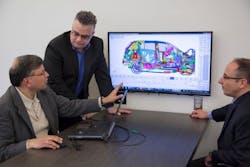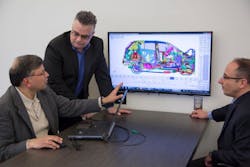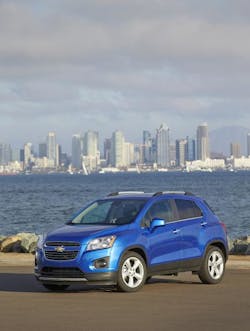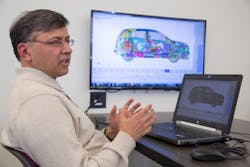Yet this time-honored engineering regimen is rapidly shifting away from the physical realm into the sphere of virtual reality.
Al Manzor (standing the photo at right), regional chief engineer for small and compact vehicles for General Motor’s North American operations, recently provided some detailed insight into the way a good chunk of vehicle crash testing is now being “digitized” within his department.
“The vehicles in the computer models are complete 3-D replicas of the physical vehicles, so the simulations accurately depict the way all parts of the structure and components would react in a crash,” he explained. “The understanding we gain by using these tests allows us to make more informed decisions regarding the final designs.”
Using the new 2015 Chevrolet Trax as an example, Manzor noted that though GM continues to use physical crash testing – such as barrier crash tests – as such testing still provides “great insight” as to how vehicles perform in collisions, it consumers a lot of precious engineering time.“Creating the tooling to build a physical prototype can take weeks or months,” he pointed out. “Setting up the cameras, test rigs, crash test dummies, sensors, and other hardware for a physical test also adds considerable time.”
And once a prototype vehicle is used in a crash test, there are limited possibilities for the vehicle to be used in another test, Manzor stressed.
“If engineers need to test for different variables or evaluate a revised part, a new batch of prototype vehicles would need to be built in order to continue testing,” he emphasized.
That not only takes more time, it costs some serious coin, too. Thus, enter virtual crash testing.
“Advanced digital models and simulations allow engineers to address challenges early in the vehicle design process, and to do it over and over,” Manzor noted.
Rendered directly from digital design files, such “virtual” vehicle models do not just incorporate every last nut and bolt that would be found on a physical vehicle, he explained; they are further broken down into finite elements, which allow engineers to precisely model and evaluate how a physical part will behave once manufactured.Sajid Syed (at right), GM’s safety team lead for the Trax, added that such digital vehicle crash models may consist of 6 million to 7 million elements, requiring advanced supercomputers several hours to put through a simulated test.
Yet that allows engineers to truly “see” inside and out how a vehicle will perform in a collision, often from angles difficult to replicate with a physical test.
“In a physical crash test, high-speed cameras allow us to see how a vehicle performs in a collision from certain angles – say, from within the passenger compartment,” Syed explained. “But the virtual testing allows us to see much more detail. Not only can we look through the vehicle as if its outer skin was transparent, but we can also view how a single part behaves.”
“A crash event may take only 100 milliseconds, but we’re able to step through millisecond by millisecond, and see the sequence of events that might be unfolding beneath the surface,” added Ken Bonello, GM’s senior manager of safety computer-aided engineering (CAE) integration
“We can look at the forces applied to the vehicle’s structure, determine what part might be affected next, and design the vehicle so it channels energy in a way that best protects the occupants,” he emphasized.
Bonello noted, too, that while safety is focus of such digital crash testing, the same technology helps engineers evaluate noise, vibration, durability, aerodynamics, fuel economy, and other critical vehicle qualities.
“All these groups are using the same models; the same set of math data,” he stressed. “It’s a very integrated and coordinated effort.”



